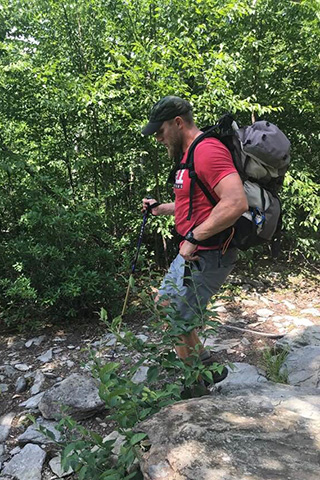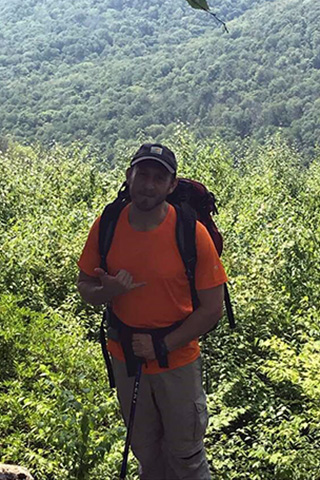The eerie morning mist was still lifting from the forest floor while sunray fingers broke through the Allegheny trees above and touched the lush vegetation and sea-green rock faces that guided the brook below. Engulfed and enchanted by the totality of verdant space that beset me, I understood at once that I was experiencing perhaps the epitome of an eastern deciduous forest in all its rapture.
Lured by postcard forest scenery, fabled “ghost towns,” and the liberation that comes with thrusting oneself “into the wild,” my brother Eric and I put one foot in front of the other along the Old Logger’s Path that traverses some truly picturesque and heritage-laden places in the mountainous regions of our state.
A Trail with Rich History
Old Loggers Path is an orange-blazed long-distance backpacking trail that follows former railroad grades, logging roads, bark trails, and other remnants of old industrial transportation, hence the name. The trail is a circuit through remote areas in northeastern Lycoming County.
Our starting point, Masten, once was the site of a lumber mill company town (and later a CCC camp) where some ruined infrastructure, such as that of some previously standing houses and dam used for saw operation, can still be seen. In 1905, the mill town was founded by Charles Sones and was sold a little over 10 years later to the giant Pennsylvania Lumber Company.
The Susquehanna & New York railroad grades that once serviced the area now support much of the Old Logger’s Path, and Eric and I set out on those on our first day to cover 17 miles of the 27-mile circuit hike.
Enjoying the Journey

Eric hiking during our Old Loggers Path journey.
Eric and I selected some sweltering, 90-degree weather for hiking, so swimming to cool off became the norm. Conveniently, the trail passes alongside the shaded and quite spectacular Rock Run for some its course, and the deep pools and cool-running flows there provided some relieving space for chilling out and gathering clear water in the middle of the day.
By evening, we reached the shores of Pleasant Stream, where we set up camp, swam again, and cooked food for the evening on my portable stove.
While cooking streamside, I noticed first-of-all the brook trout rising in the pools to feed on the evening’s critters -- a sight which brought me great delight -- and I regretted instantly that I was without my fly rod.
Secondly, I noticed the severe impacts from the 2016 storm that flooded the landscape and drastically altered the stream channel, leaving in its wake a dramatic wash-out of small boulders that undoubtedly originated from farther up the drainage.
After supper, Eric and I settled in for the evening by a campfire and recounted some thematic, funny moments of the day before turning in.
At about five o’clock in the morning, it began to rain. Hard. These are the moments when it pays dividends to come prepared with the right gear. In my case, that meant a tent I could rely on to keep the water out, and sleeping pad that let me roll over and sleep somewhat comfortably for a few more hours until the rain stopped!
When the skies finally cleared, the site was a little muddy, but I was grateful for the extra sleep. We made some instant coffee, packed our gear, and headed out.
Connecting People to Penn’s Woods
As we climbed out of the Pleasant Stream valley on the second day, we came upon a big “clearing” in the forest with some yellow equipment parked within, and I took advantage of the opportunity to explain to Eric the timber harvesting process that continues in Penn’s Woods. Eric still lives around Bucks County, where our family is from, so I think the sight surprised him.
As I dropped some more education on my “little” brother, I was reminded of what an important role DCNR’s Bureau of Forestry has in connecting people with land resources and all the opportunities it has to illustrate and educate about the effects of those connections.
Our state is rich in natural resources, and the utilization of trails like Old Logger’s Path, has provided for the fitness of many families -- past, present, and hopefully into the future, if we apply wisdom.
Nature from the Bird’s Eye View

Me (Michael) in front of a beautiful vista.
Later, we came out to a few vistas that looked over the valley below. Being up high really gave us the vantage to perceive so much of the land at once. It really felt like having a “bird’s eye view.”
The views were wide and expansive, going on for miles. It was a great place to stop and contemplate our place in the world before moving on to the last leg of the hike.
Back to the Beginning, Feeling like New
Later in the day, we finished where we started -- at Masten. Everything looked the same, but I knew we emerged changed for the better, with a fresh perspective, enriched by our experience. Eric and I talk about it often, and we always have our sights set on the next opportunity.
While wilderness travel, on some level, translates to some dimension of physical discomfort, the rewards that come from feelings of accomplishment, aesthetic experience, and transcendental connectedness can be great. In the case of the Old Logger’s Path, the juice was worth the squeeze!
Learn more
Find more Pennsylvania trails in the deep woods or close to home at www.explorePAtrails.com.